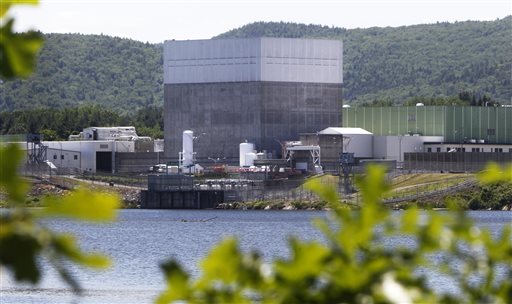BRATTLEBORO, Vt. — Even after the Vermont Yankee nuclear plant is officially decommissioned, it will take decades to clear the site of nuclear material, largely because there’s no place in the country to put the high-level spent fuel.
Entergy Corp. announced on Tuesday it would shutter the 41-year-old plant at the end of next year then put it in “safe-store,” an industry term that means the plant will be mothballed, possibly for decades.
The thinking goes like this: Over the years, radioactivity decreases, meaning there is less exposure to workers and less risky material to transport and ultimately bury at an approved waste site. But that’s the low-level material: hardware, contaminated concrete, and other building materials that will end up in a specialized Texas burial site.
A long-debated federal proposal to entomb the high-level waste at a Yucca Mountain facility in Nevada has gone nowhere, leaving no place to safely dispose of the guts of nuclear power: Spent uranium fuel and its byproducts. So, massive dry casks will hold the fuel on site, secured by guards, for up to 60 years.
In an emailed response to questions Wednesday, Entergy said there are 13 air-cooled storage casks currently on site, containing just under 900 spent fuel assemblies. But there are 3,000 spent fuel assemblies currently being held in a water-filled pool that would have to be packed away. The final number that would have to be stored on site depends on when the Department of Energy begins taking spent fuel.
Other plants that have closed over the years in New England are still dotted with the casks: Maine Yankee (formally decommissioned in 2005) has 60 dry casks; Connecticut Yankee (decommissioning completed in 1997) has 43 casks; and Yankee Rowe (2007) has 16 casks.
Howard Shaffer, an engineer and consultant who supports nuclear energy, said history shows plants can be decommissioned safely and that companies must strike a balance between caution and efficiency when dismantling a plant.
“Decommissioning is a careful and slow process,” said Shafer, who lives in New Hampshire. “It’s like tearing down a house, piece by piece.”
“But you don’t want to dawdle, because then you run the costs up,” he said.
Many state officials want the nuclear material off-site as soon as possible, but even removing low-level radioactive material must wait at least five years, according to Arnie Gundersen, chief engineer for Fairewind Gundersen, a nuclear consulting firm in Vermont.
“When a reactor shuts down, it remains physically hot for five years and it has to stay underwater to stay cool,” Gundersen said.
Raymond Shadis, technical adviser to the New England Coalition that fought to close Vermont Yankee, was part of the process to decommission Maine Yankee, an undertaking that took seven years.
“What we found was prompt decommissioning was not only the cheapest way to go, but also in terms of getting a site that was well-cleaned up, it was the most effective way,” he said.
Shadis said moving quickly means not having to maintain the plant’s buildings while work is done. Access to local employees familiar with the plant also adds expertise and efficiency to a prompt closure, he said.
Vermont Yankee was commissioned in 1971 on the bank of the Connecticut River in Vernon in the state’s southeast corner. After Louisiana-based Entergy bought the plant in 2002 from a group of New England utilities, state officials made it clear they wanted the plant shut after its license expired and the issue landed in court.
The company said a poor energy market and increased competition from natural gas drove the decision to close the plant.
Send questions/comments to the editors.



Success. Please wait for the page to reload. If the page does not reload within 5 seconds, please refresh the page.
Enter your email and password to access comments.
Hi, to comment on stories you must . This profile is in addition to your subscription and website login.
Already have a commenting profile? .
Invalid username/password.
Please check your email to confirm and complete your registration.
Only subscribers are eligible to post comments. Please subscribe or login first for digital access. Here’s why.
Use the form below to reset your password. When you've submitted your account email, we will send an email with a reset code.